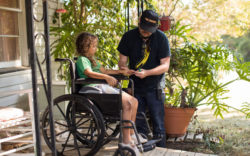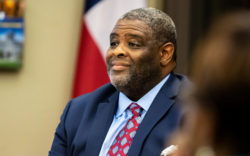With a little white paint, the intersection of Baldwin Street and Sanford Drive recently became a little more bicycle-friendly.
The repainting gave bicyclists on the University of Georgia campus a lane that runs opposite vehicle traffic on Sanford Drive. It’s the first step in a much larger master plan suggesting ways to integrate bicycle lanes and other bike-friendly improvements across campus, a collaboration between UGA’s Office of Sustainability, the Office of University Architects, Koons Environmental Design and various bike advocacy groups in the area.
Kevin Kirsche, director of the Office of Sustainability, expects to see finalized plans within a week. “Then,” he says, “we’ll take it up the levels at UGA to get it officially recognized. The next phases are a more formal acknowledgment of the plan and figuring out the next steps and the logical order.”
If and when it’s put in place, the bike master plan will provide an overall look at how bicycles can connect across campus, installing bike lanes, racks or other amenities to increase the ease of cycling and encourage alternative transportation, Kirsche says. But these changes won’t be set into specific construction phases. Instead, according to Kirsche and Scott Simpson with the UGA architects, changes will come in conjunction with planned road improvement projects. For example, if a road identified on the master plan for a bike lane is due to be repaved, the lane will be added as part of the scheduled construction. Simpson says UGA architects can work closely with the Physical Plant and Environmental Safety departments to determine upcoming road work where bike lanes could be implemented.
“Re-striping [to accommodate a bike lane] is inexpensive, but not free,” adds Simpson, the project manager for campus planning and design. “So, while it would affect the cost of a project, it is less expensive than something more invasive, such as grading and pouring new curbs and gutters.”
The bike master plan became a project of the Office of Sustainability following requests from students to help the campus become more bike-friendly, Kirsche says. But, the project also looked at traffic flow for cars, buses and pedestrians coming through campus, as well as the effect that more bike education and safety can have on overall bike usage.
Erik Ladd, an associate landscape designer at Koons Environmental Design, which drew up the plans, says it was also important to get input from other groups, like BikeAthens, because Athens residents who bike to work, whether affiliated with the university or not, can come into contact with the UGA campus along their routes. Even he bikes through campus on his way to work, from South Milledge to his office on Pulaski Street, Ladd says.
“We felt that it was really appropriate to look at what had been going on, on the city’s side of this, because they have their own bicycle master plan going on,” Ladd says. “We were trying to bridge the gap between what the school wants to do and what the city wants to do, because it’s a really small community, and people who are biking through campus or through town, they are really the same people.”
At this point, Lumpkin Street and East Campus Road already have bike lanes. During the winter break, the lane and arrows were added to Sanford Drive to allow cyclists to travel opposite vehicles driving north on the one-way street. But many other places—specifically intersections—are considered “conflict areas,” where bicycles, vehicles and pedestrians collide, so to speak. Some of the campus plan’s next steps may include bike lanes on Baldwin, Carlton and Cedar streets, Kirsche says, and also connecting them with Sanford. That would allow greater ease of movement across major corridors on campus.
“Intersections are always a challenge because you have a number of people and cars and bikes going in different directions,” he explains. “We looked at a number of plans to give bikes more prominence and safer conditions.”
Bicycle education is also an important aspect of the plan. When students and community members were surveyed, it became clear that few knew all the rules of the road. UGA Police Chief Jimmy Williamson says officers could be found last semester on Sanford Drive, handing out information about safe cycling—not tickets—to cyclists riding the wrong way down the street.
“They were in conflict with vehicular traffic, and we had a number of complaints. So, we put some officers there,” he recalls. “Since that time, that section has been repainted and relabeled.”
Williamson says the number-one complaint he receives about bicyclists is that they are not following the rules of traffic. Some weave between cars in traffic while others switch from riding on the road to the sidewalk, cutting through an intersection at a red light by using crosswalks.
“I constantly try to remind everyone that we all have got to interact in a closed, congested area, so we all need to slow down,” he says. “But the campus is fairly open with bicyclists, and we try to work with bicyclists on sidewalks because of their size… but if you are using a sidewalk, you need to be mindful of pedestrians.”
Kirsche says the Office of Sustainability—funded through a $3 fee per semester per student—helped pay for the study because it fell under the guidelines of UGA’s long-term sustainability plan. And hopefully, he says, the study will be well received by the university, offering an overall plan that welcomes more alternative transportation.
“This is something that will be implemented over time,” Kirsche says. “It provides a road map and will help identify the key next steps in implementation, so when there is a road improvement project, we’ll know this is the right direction.”
Like what you just read? Support Flagpole by making a donation today. Every dollar you give helps fund our ongoing mission to provide Athens with quality, independent journalism.









